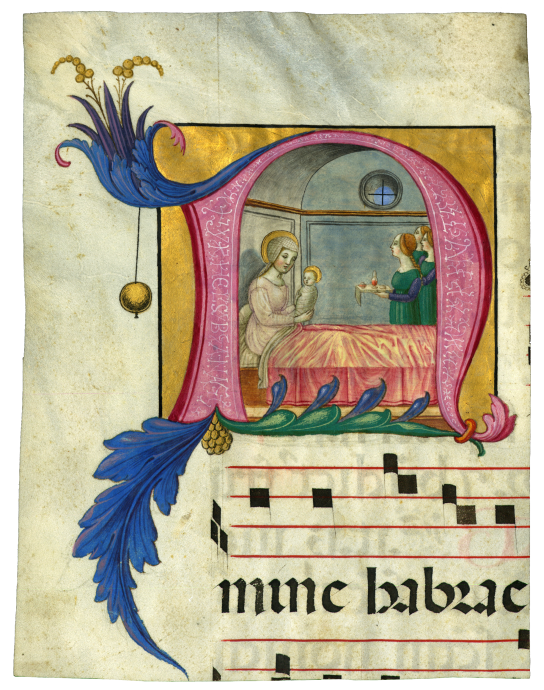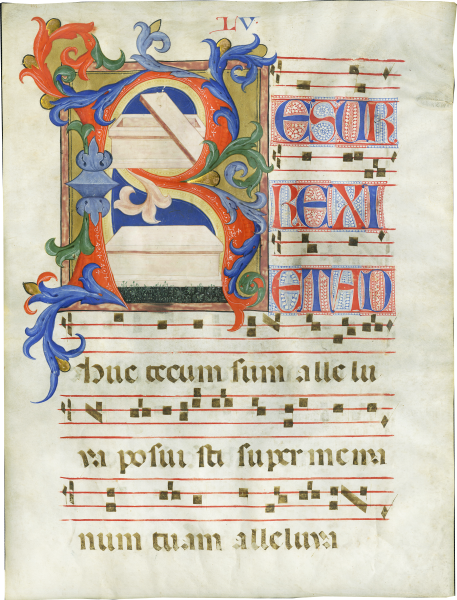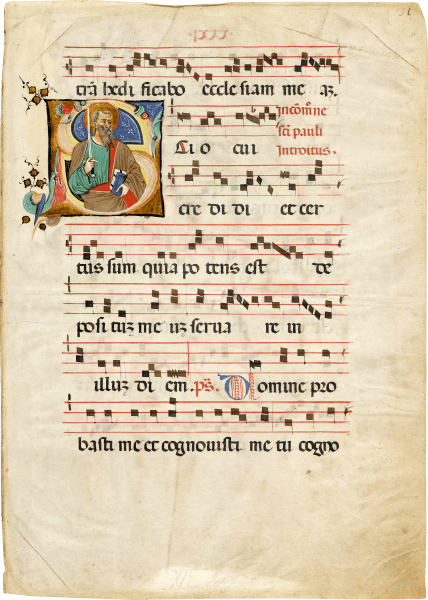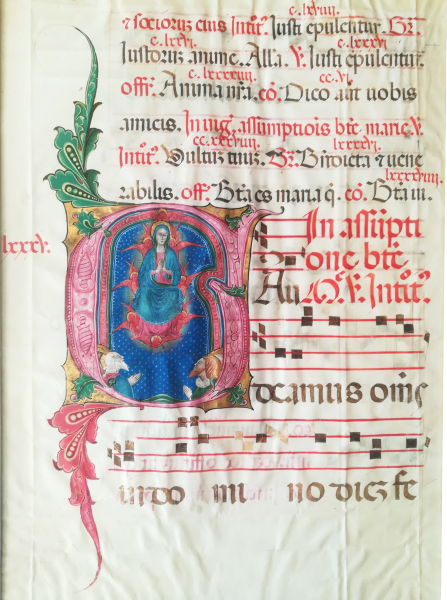


Scriptorium of Santa Maria di Castello (Ludovico da Taggia?)
, Italy, Genoa, c. 1490–1500Scriptorium of Santa Maria di Castello (Ludovico da Taggia?)
Description
Harmonizing styles of Liguria and Lombardy, this vibrant initial ‘N’ was created by the prominent Dominican scriptorium of Santa Maria di Castello in Genoa near the end of the fifteenth century. Painted on a square gold ground, the pink letter is traced with a white fillagree of letterforms and vegetal motifs while acanthus foliage in green and blue sprout from the stem with clusters of small golden fruit emerging between. Inside, the Birth of the Virgin is depicted within a dim monastic cell lit by a small oculus in the far wall. Saint Anne cradles the swaddled infant Mary in her arms as the two rest on a low bed covered by a thin pink fabric. Three handmaidens, identically arrayed in blue and green garments, bring refreshments of wine and bread. The initial ‘N’ begins the antiphon: Nativitas gloriosae Virginis Mariae, ex semine habrae Abrahae… sung at the office of Vespers on Marymas, the feast of the Nativity of the Virgin Mary on September 8. On the recto, the text contains the Communion for the Mass: Beatam me dicent omnes generationes Quia fecit mihi....
The style and ornamentation of this initial closely match those produced at the scriptorium of Santa Maria di Castello, identified by Anna De Floriani in a series of studies (De Floriani 1986, 1985, 1982, 1977, 1975). In particular, the clusters of small golden fruit nested between blue, pink, and green acanthus leaves are indicative of the scriptorium, as seen for instance in the Gradual of Santa Maria di Castello painted around 1490–1510 (fig. 1, Oristano, Archivietto della Cattedrale, Ms. P. II; see Toniolo 2009, pp. 171–84). The initial itself may have been painted by Ludovico da Taggia who joined the monastery of Santa Maria di Castello in 1476 and is known through his signature in an Antiphonal painted for the convent of San Domenico di Taggia in 1491 (Tognoli Bardin 2004). While Taggia was once believed to be the leader of a “school” of illuminators at Santa Maria di Castello, it is more likely that he painted initials with a specialty in filigree. (De Floriani 1983, 126–31; Improta 2016, 41).
The figurative style of the miniature itself points to Lombardy and suggests a painter from that region. It is likely this artist came from within the circle of the so-called Master of the Antiphonary X of Our Lady of Consolation in Genoa, identified by De Floriani, who directed a thriving workshop from at least 1482 when he decorated the codex of his namesake (De Floriani 2004). Potentially, this unknown painter may be the same hand that assisted the Master of Antiphonary X in the completion of a nocturnal Psalter commissioned by the prior of the Santa Maria di Castello monastery, Vincenzo Maglio, in 1501 (fig. 2, Genoa, S. Maria di Castello; cf. Toniolo 2009, pp. 154–55). Profoundly influenced by Lombard models, this artist painted in a style similar to our miniature, notably the ponderous, weighty drapery, oval faces, and physiognomies characterized by the underlining of the eyelids and arched eyebrows. This painter has only recently been identified and his oeuvre is largely unknown beyond the 1501 Psalter and an Invitatorial in the Brindisi collection (IL. MS. A/7; see Improta 2016).
We are grateful to Federica Toniolo for expertise.
Literature:
Unpublished; for comparisons and further reading, see:
Algeri, G. and A. De Floriani, La pittura in Liguria: Il Quattrocento, Genoa, 1991.
De Floriani, A. “Maestro dell’Antifonario X di N. S. della Consolazione a Genova,” in Dizionario biografico dei miniatori italiani, secoli IX–XVI, ed. M. Bolotti, Milan, 2004, pp. 553–55.
De Floriani, A. “La miniatura in Liguria nella seconda metà del Quattrocento: un bilancio provvisorio e schede nn. 18, 23,” Nicolo Corso: un pittore per gli Olivetani, ed. G. Rotondi Terminello, Genoa, 1986, pp. 151–57, 171–75.
De Floriani, A. “Miniature di alcuni complessi liturgici genovesi del Quattrocento,” in La miniatura italiana tra Gotico e Rinascimento, Florence, 1985, I, pp. 435-450.
De Floriani, A. “Le miniature dei corali quattrocenteschi di N. S. della Consolazione a Genova,” La Berio XXII, 1/2 (1982), pp. 5–84.
De Floriani, A. “Due corali miniati trecenteschi e un codice firmato da Ludovico da Taggia,” Studi di Storia delle Arti Genova 4 (1981), pp. 7–24.
De Floriani, A. “I Corali miniati di Santa Maria delle Vigne a Genova,” Studi di storia delle arti: Università di Genova, Instituto di storia dell’arte (1977), pp. 79–89.
De Floriani, A. “La miniature dei corali di Santa Maria di Castello a Genova,” La Berio XV, 1 (1975), pp. 30–42.
Improta, A. “Un Invitatoriale genovese miniato del 1495: il ms. A/7 della Biblioteca arcivescovile ‘A. De Leo’ di Brindisi,” in Per la conoscenza dei Beni Culturali. VI. Ricerche del Dottorato in Metodologie conoscitive per la conservazione e la valorizzazione dei beni culturali, 2015–2016, Santa Maria Capua Vetere, 2016, pp. 37–46.
Tognoli Bardin, L. “Ludovico da Taggia, frate,” in Dizionario biografico dei miniatori
Italiani, secoli IX-XVI ed. M. Bolotti, Milan, 2004, pp. 404–405.
Toniolo, F. “Le miniature nei codici liturgici del XIV e XV secolo della Cattedrale di Oristano: casi di importazione di opere toscane e liguri,” Die ac Nocte: I Codici Liturgici di Oristano: dal Giudicato d’Arborea all’età spagnola (secoli XI-XVII), Cagliari, 2009, pp. 141–94.


